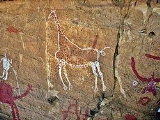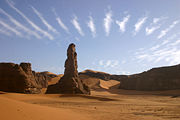
Tadrart Acacus
Encyclopedia



Libya
Libya is an African country in the Maghreb region of North Africa bordered by the Mediterranean Sea to the north, Egypt to the east, Sudan to the southeast, Chad and Niger to the south, and Algeria and Tunisia to the west....
, part of the Sahara
Sahara
The Sahara is the world's second largest desert, after Antarctica. At over , it covers most of Northern Africa, making it almost as large as Europe or the United States. The Sahara stretches from the Red Sea, including parts of the Mediterranean coasts, to the outskirts of the Atlantic Ocean...
. They are situated east of the Libyan city of Ghat and stretch north from the Algeria
Algeria
Algeria , officially the People's Democratic Republic of Algeria , also formally referred to as the Democratic and Popular Republic of Algeria, is a country in the Maghreb region of Northwest Africa with Algiers as its capital.In terms of land area, it is the largest country in Africa and the Arab...
n border about 100 km. Tadrart means 'mountain' in the native language of the area (Tamahaq language
Tamahaq language
Tamahaq is the only known Northern Tuareg language, spoken in Algeria, western Libya, and northern Niger. It varies little from the southern languages of Ayr, Azawagh or Adagh, with the differences mostly being substitution of sounds, for instance Tamahaq instead of Tamajaq or...
). The area has a particularly rich array of prehistoric rock art
Rock art
Rock art is a term used in archaeology for any human-made markings made on natural stone. They can be divided into:*Petroglyphs - carvings into stone surfaces*Pictographs - rock and cave paintings...
.
The Acacus Mountains have a large variation of landscapes, from differently coloured sanddunes to arches, gorges, isolated rocks and deep ravines (wadi
Wadi
Wadi is the Arabic term traditionally referring to a valley. In some cases, it may refer to a dry riverbed that contains water only during times of heavy rain or simply an intermittent stream.-Variant names:...
s). Major landmarks include the arches of Afzejare and Tin Khlega. Although this area is one of the most arid of the Sahara, there is vegetation, such as the medicinal Calotropis procera, and there are a number of springs and wells in the mountains.
The area is known for its rock-art and was inscribed as a UNESCO
UNESCO
The United Nations Educational, Scientific and Cultural Organization is a specialized agency of the United Nations...
World Heritage Site
World Heritage Site
A UNESCO World Heritage Site is a place that is listed by the UNESCO as of special cultural or physical significance...
in 1985 because of the importance of these paintings and carvings. The paintings date from 12,000 BC to 100 AD and reflect cultural and natural
Nature
Nature, in the broadest sense, is equivalent to the natural world, physical world, or material world. "Nature" refers to the phenomena of the physical world, and also to life in general...
changes in the area. There are paintings and carvings of animals such as giraffe
Giraffe
The giraffe is an African even-toed ungulate mammal, the tallest of all extant land-living animal species, and the largest ruminant...
s, elephant
Elephant
Elephants are large land mammals in two extant genera of the family Elephantidae: Elephas and Loxodonta, with the third genus Mammuthus extinct...
s, ostrich
Ostrich
The Ostrich is one or two species of large flightless birds native to Africa, the only living member of the genus Struthio. Some analyses indicate that the Somali Ostrich may be better considered a full species apart from the Common Ostrich, but most taxonomists consider it to be a...
es and camel
Camel
A camel is an even-toed ungulate within the genus Camelus, bearing distinctive fatty deposits known as humps on its back. There are two species of camels: the dromedary or Arabian camel has a single hump, and the bactrian has two humps. Dromedaries are native to the dry desert areas of West Asia,...
s, but also of men and horse
Horse
The horse is one of two extant subspecies of Equus ferus, or the wild horse. It is a single-hooved mammal belonging to the taxonomic family Equidae. The horse has evolved over the past 45 to 55 million years from a small multi-toed creature into the large, single-toed animal of today...
s. Men are depicted in various daily life situations, for example while making music and dancing.
Recently, the search for petroleum hidden underground has placed the rock art itself in danger. Seismic hammers are used to send shock waves underneath to locate oil deposits, and have noticeable effects on nearby rocks, including the ones that house the Tadrart Acacus rock art.
Further reading
- Di Lernia, Savino e Zampetti, Daniela (eds.) (2008) La Memoria dell'Arte. Le pitture rupestri dell'Acacus tra passato e futuro, Florence, All'Insegna del Giglio;
- Minozzi S., Manzi G., Ricci F., di Lernia S., and Borgognini Tarli S.M. (2003) "Nonalimentary tooth use in prehistory: an Example from Early Holocene in Central Sahara (Uan Muhuggiag, Tadrart Acacus, Libya)" American Journal of Physical Anthropology 120: pp. 225–232;
- Mattingly, D. (2000) "Twelve thousand years of human adaptation in Fezzan (Libyan Sahara)" in G. Barker, Graeme and Gilbertson, D.D. (eds) The Archaeology of Drylands: Living at the Margin London, Routledge, pp. 160–79;
- Cremaschi, Mauro and Di Lernia, Savino (1999) "Holocene Climatic Changes and Cultural Dynamics in the Libyan Sahara" African Archaeological Review 16(4): pp. 211–238;
- Cremaschi, Mauro; Di Lernia, Savino; and Garcea, Elena A. A. (1998) "Some Insights on the Aterian in the Libyan Sahara: Chronology, Environment, and Archaeology" African Archaeological Review 15(4): pp. 261–286;
- Cremaschi, Mauro and Di Lernia, Savino (eds., 1998) Wadi Teshuinat: Palaeoenvironment and Prehistory in South-western Fezzan (Libyan Sahara) Florence, All'Insegna del Giglio;
- Wasylikowa, K. (1992) "Holocene flora of the Tadrart Acacus area, SW Libya, based on plant macrofossils from Uan Muhuggiag and Ti-n-Torha Two Caves archaeological sites" Origini 16: pp. 125–159;
- Mori, F., (1960) Arte Preistorica del Sahara Libico Rome, De Luca;
- Mori, F., (1965) Tadrart Acacus, Turin, Einaudi;

